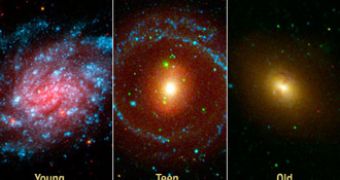An American astronomer, named Edwin Hubble, first discovered that there are other galaxies in the universe besides our Milky Way in the early 1900s, and dubbed them "island universes". After a century of studying these cosmic objects, NASA's Galaxy Evolution Explorer is putting together the evolution of these cosmic species.
The mission, launched in 2003, observed tens of thousands of galaxies in the ultraviolet spectrum, across nine billion years of time. The result of the survey showed that the galaxies observed by Hubble, the spiral and the elliptical galaxies are linked together evolutionarily. Young galaxies begin their lives as spiral galaxies, actively producing new stars, merging in other spiral or irregular galaxies, before beginning a new process of forming stars. Nevertheless, once the galaxy has depleted its fuel, the star forming process slows down and eventually stops, and the galaxy transforms into an elliptical galaxy.
Evidence shows that all galaxies start their lives by forming stars, and through a process of merging, fuel exhaustion or black hole suppression, the star forming process it stopped. The age of a galaxy can be better appreciated by the color, rather through their shape, with a few exceptions. Young galaxies, give off light mostly closer to blue, revealing that they are actively producing new stars. Older galaxies emit light in the infrared or red light spectrum, meaning that the star forming process is mostly stopped.
The statistical evaluation of the galaxies' colors show that roughly half of all galaxies are blue and half red. It is well known that, as galaxies grow older, they shift from blue and end up to become red. Astronomers suggested that this is happening due to the lack of material, or gas to create new stars, however for this to be true there would have to exist a population of 'teenage', galaxies which presents this color transition. But the evolution of galaxies takes billions of years to observe.
The color shift can only be observed by studying a massive number of galaxies, to find these teenage galaxies, as proof that young spiral galaxies evolve in time to become elliptical, red, galaxies. The theory of galaxy evolution predicts that there would exist certain galaxies in transition, but finding them takes so long due to the fact that they are extremely rare, and the study must be done in ultraviolet light on a large number of galaxies.
Observations made in the visible light spectrum by Sloan Digital Sky Survey, also help determine a galaxy's age, and the rate at which they are running out of fuel. Calculations show that some of the young galaxies are evolving extremely fast into old galaxies, while others evolve over a very long period of time.

 14 DAY TRIAL //
14 DAY TRIAL //